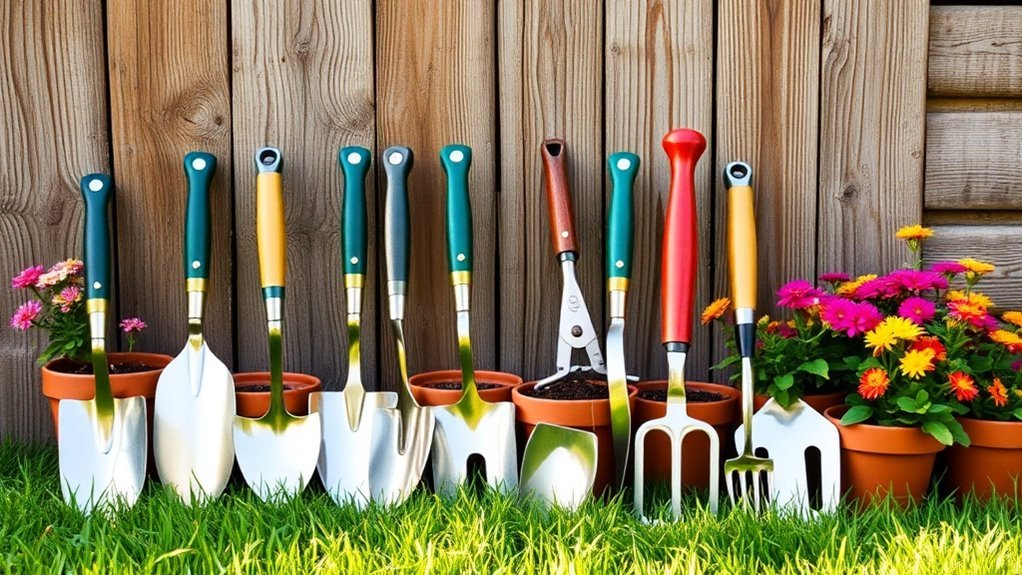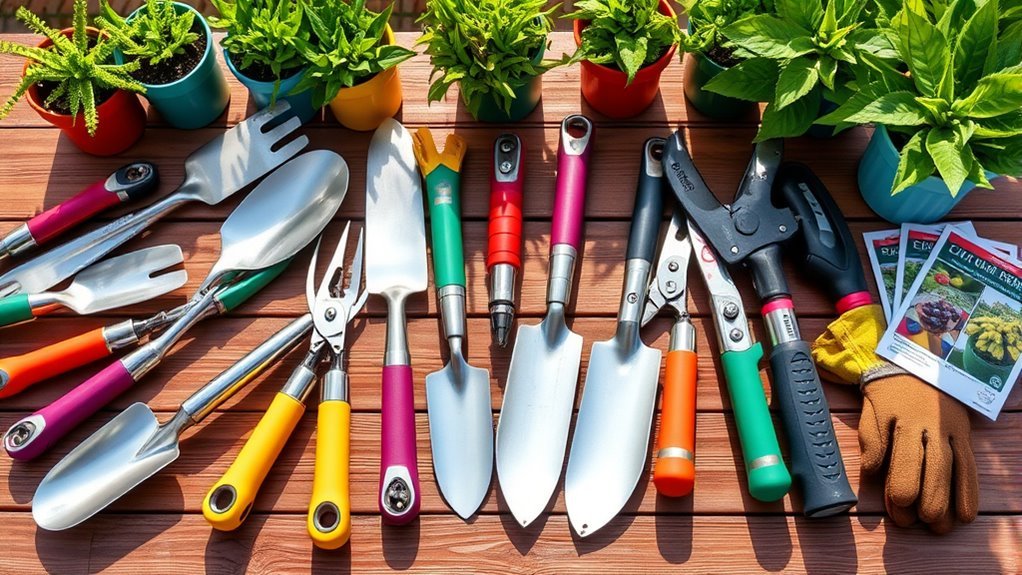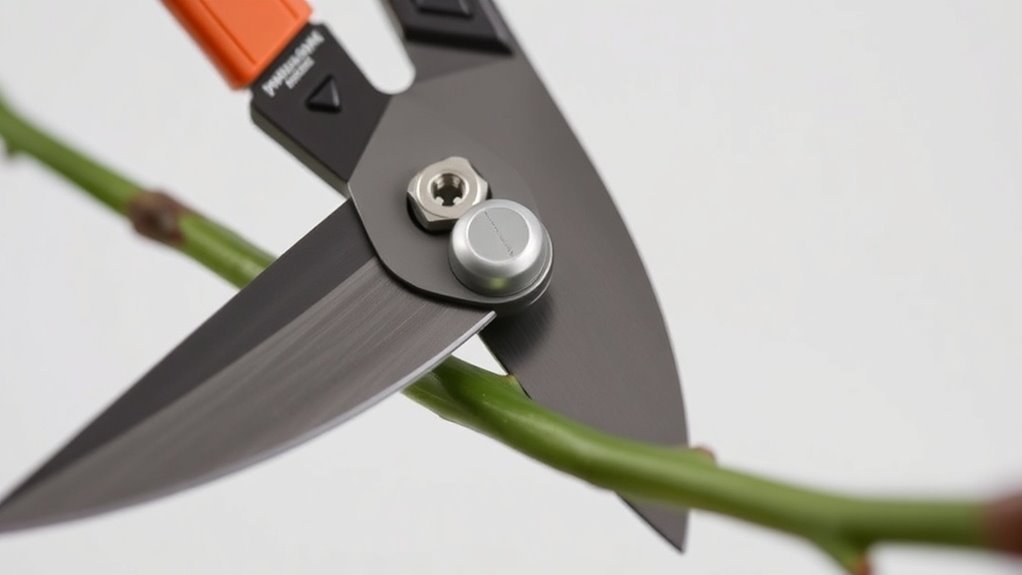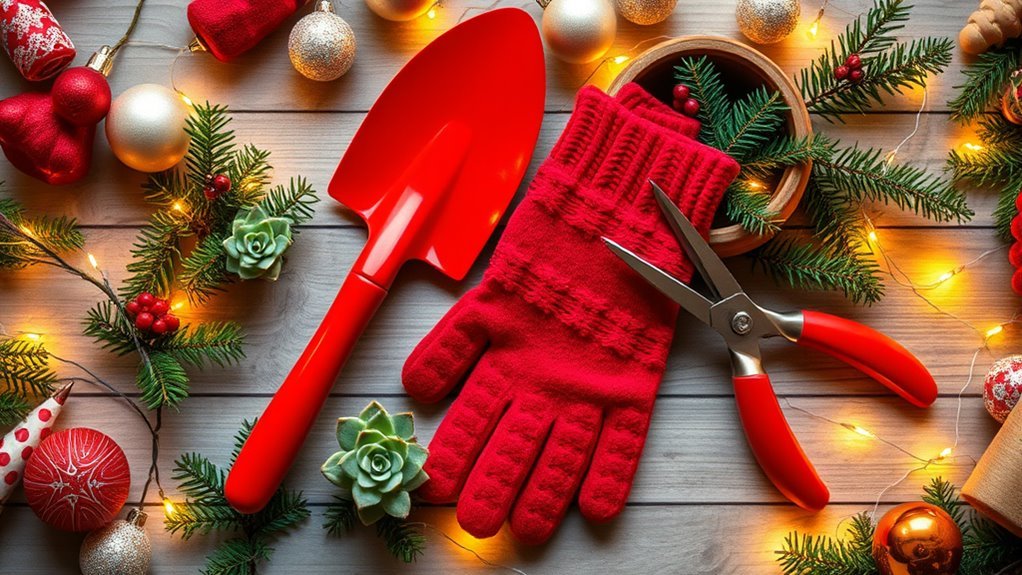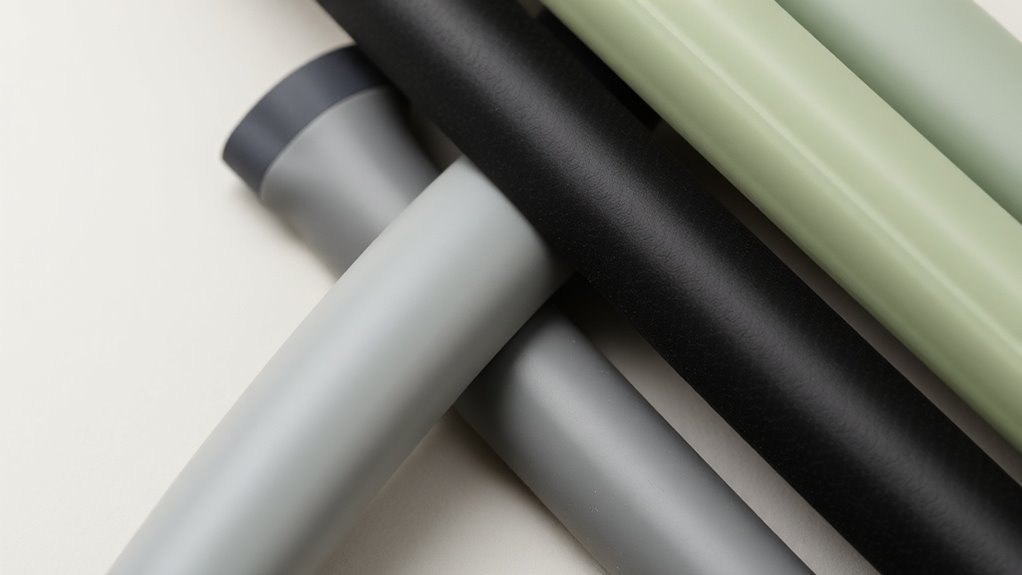How Weather Affects Garden Tool Durability
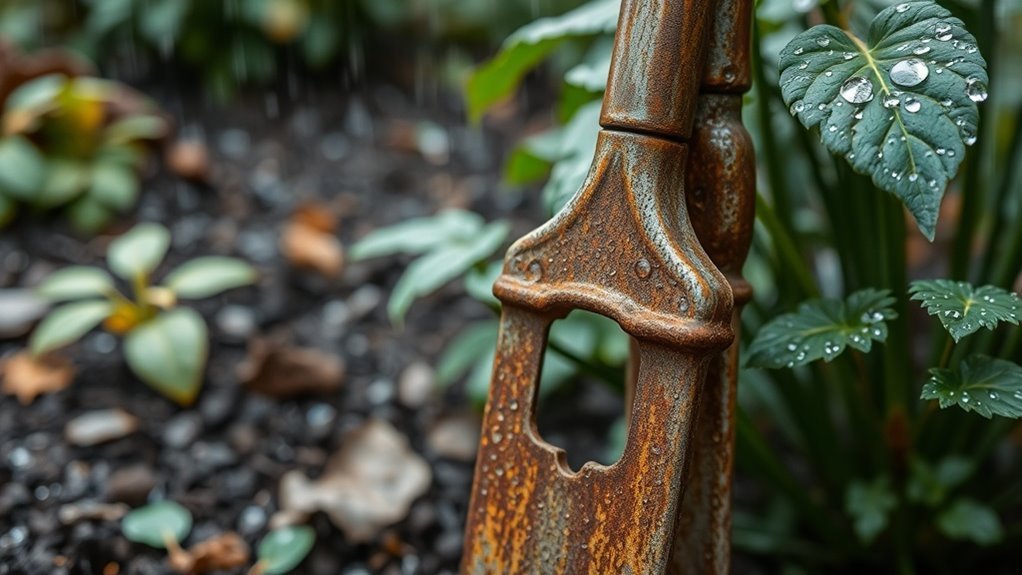
Weather impacts your garden tools’ durability in various ways. Extreme temperatures can cause warping or brittleness, while high humidity leads to rust and moisture damage. UV exposure can make plastic tools fragile and degrade wooden handles. Proper storage in dry, controlled environments helps protect your tools from harsh elements. Regular maintenance, like oiling metal parts and checking wooden handles, can extend their lifespan. Discover more about effective strategies to keep your tools in top shape.
Key Takeaways
- Extreme temperatures cause metal warping, while freezing conditions can make materials brittle, leading to breakage and reduced tool reliability.
- Humidity increases corrosion risk on metal tools, while excessive moisture damages wooden handles and can lead to warping or splintering.
- Prolonged UV exposure deteriorates plastics, makes metal surfaces prone to rust, and affects the finish of wooden handles, impacting functionality.
- Proper storage in dry locations and using protective covers can prevent moisture accumulation and protect tools from harsh weather conditions.
- Regular maintenance, like sharpening blades and oiling metal parts, enhances the lifespan and effectiveness of garden tools against weather impacts.
The Impact of Extreme Temperatures
When you consider how extreme temperatures affect your garden tools, you mightn’t realize just how much they can take a toll. High heat can cause metal components to expand, leading to warping or misalignment, while freezing temperatures can make certain materials brittle and prone to breaking.
Frequent temperature swings can exacerbate these issues, making your tools less reliable over time. Wooden handles can swell and crack when exposed to extreme heat or cold, compromising your grip and control.
Even plastic tools can degrade under ultraviolet rays and extreme cold, turning them fragile. To prolong your tools’ lifespan, store them in a climate-controlled environment when not in use, shielding them from the harshest elements. Extreme temperatures can lead to material degradation, making it essential to understand how to care for your tools effectively.
Proper care pays off in durability and performance.
Humidity and Its Effects on Tools

Humidity can greatly impact your garden tools, increasing the risk of corrosion. If you don’t take the right maintenance precautions, you might find your tools degrading faster than expected. Understanding these effects can help you protect your investment and guarantee your tools stay in top shape. Applying protective coatings like oils or rust inhibitors can significantly prolong the life of your tools when stored in humid conditions.
Corrosion Risk Factors
As you tend to your garden, it’s essential to remember that elevated humidity levels can greatly impact the durability of your tools. High humidity creates an ideal environment for corrosion, particularly on metal surfaces. When moisture settles on tools, it can lead to rust formation, weakening their structural integrity over time.
Even brief exposure can pose a risk if tools aren’t dried promptly after use.
Moreover, stored tools in damp sheds or garages are even more vulnerable, as stagnant air traps humidity, increasing exposure to corrosion. This risk isn’t limited to just metal; wooden handles can also sustain damage from excessive moisture, leading to splitting or warping.
Understanding these corrosion risk factors will help you protect your valuable gardening equipment.
Maintenance Practices Needed
Proper maintenance practices can greatly extend the life of your garden tools, especially in humid conditions. Humidity can accelerate rust and mold, which is why regular upkeep is essential. Here are some essential maintenance tips:
| Task | Frequency |
|---|---|
| Clean tools after use | After every use |
| Dry tools thoroughly | After cleaning |
| Apply rust-resistant oil | Monthly |
| Store in a dry location | Year-round |
Rain and Moisture Damage
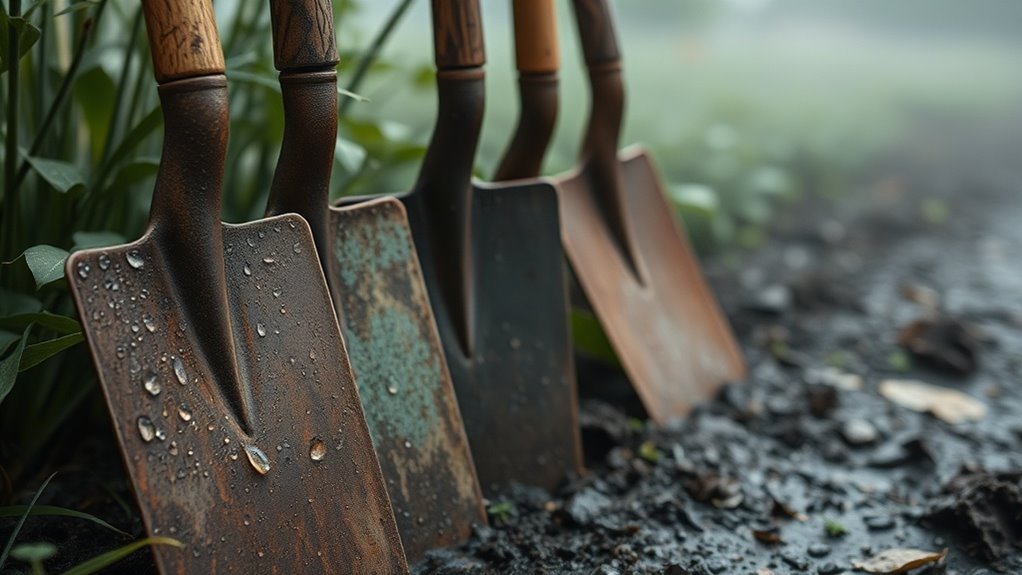
How can rain and moisture impact the longevity of your garden tools? Excess moisture can lead to rust and corrosion, especially on metal parts. If you leave your tools outside, the constant exposure to rain can quickly deteriorate them, decreasing their lifespan.
Wooden handles are also at risk; they can warp, splinter, or weaken over time when exposed to wet conditions.
To protect your investment, it’s essential to dry your tools thoroughly after use and store them in a dry place. You might want to apply a rust inhibitor or linseed oil to metal surfaces to create a barrier against moisture.
UV Exposure and Material Degradation
When you leave your garden tools out in the sun, UV exposure can seriously harm their durability.
Plastic tools may become brittle and crack, while metal parts are at risk of corrosion if protective coatings wear away.
Even wooden handles can lose their finish, making it essential to contemplate how sunlight affects your gear.
Impact on Plastic Tools
Although plastic garden tools are often favored for their lightweight and affordability, prolonged exposure to UV rays can greatly compromise their durability.
The sun’s ultraviolet radiation breaks down the polymer structure of these tools, leading to fading, brittleness, and eventual cracking. Over time, this degradation can affect the functionality of your tools, making them less reliable when you need them most.
You might notice that a once-sturdy trowel now feels flimsy or a rake has developed noticeable cracks.
To protect your plastic tools, consider storing them in a shaded area when not in use or covering them with a UV-resistant tarp. Taking these precautions can considerably extend the life of your plastic tools, ensuring they’re ready for active gardening sessions.
Metal Corrosion Risks
While many gardeners appreciate the durability of metal tools, prolonged exposure to moisture and UV rays can lead to significant corrosion risks.
You should consider a few key factors to protect your tools:
- Material Quality: Premium stainless steel is more resistant to corrosion than regular steel.
- Protective Coatings: Applying rust-resistant paints or sprays can help shield the metal.
- Storage Conditions: Keep your tools dry and away from direct sunlight to minimize exposure.
- Regular Maintenance: Clean and lubricate tools after each use to prevent moisture build-up.
Wood Finish Longevity
As you use wooden garden tools, it’s essential to recognize how UV exposure can compromise their finish and shorten their lifespan. Without proper protection, the sun’s rays can lead to fading and cracking, reducing not only aesthetics but functionality, too. Here’s a quick look at how different finishes hold up against UV exposure:
| Finish Type | UV Resistance |
|---|---|
| Oil Finish | Moderate |
| Varnish | High |
| Polyurethane | Very High |
| Natural Oils | Low |
To prolong the life of your tools, consider applying UV-resistant finishes and store them in shaded areas when not in use. This way, you can keep your wooden tools looking great and performing well for years to come.
Storage Solutions for Weather Resilience
When it comes to extending the lifespan of your garden tools, effective storage solutions play an essential role.
By storing your tools properly, you can shield them from harsh weather conditions that cause rust and deterioration.
Proper storage safeguards your tools from harsh weather that can lead to rust and deterioration.
Here’s how to keep them safe:
- Dry Environment: Store tools in a dry place to prevent moisture accumulation, like a shed or garage.
- Protective Covers: Use covers for larger equipment to guard against dust and moisture.
- Tool Racks: Hang tools on wall-mounted racks to keep them off the ground and away from potential water exposure.
- Climate Control: In extreme climates, consider climate-controlled storage to maintain consistent temperature and humidity levels.
Additionally, using proper storage containers can help to protect both the tools and the user, ensuring safety and durability.
These steps will help guarantee your garden tools stay in top shape for years to come.
Maintenance Tips for Longevity
To guarantee your garden tools last as long as possible, regular maintenance is key.
Start by cleaning your tools after each use. Remove dirt and debris, which can cause rust and corrosion. For metal parts, dry them thoroughly to prevent moisture buildup.
Regularly sharpen blades using a file or sharpener; dull blades make your work harder and can lead to damage. Apply a light oil to metal components to create a protective barrier against rust.
Check wooden handles for splinters or cracks, and sand them down to keep them smooth.
Additionally, store tools in a dry, covered area to shield them from harsh weather conditions. Regular maintenance practices ensure that tools remain effective and last longer.
Questions
How Does Snow Affect Garden Tools Differently Than Rain?
Snow can trap moisture against your tools, leading to rust or corrosion, while rain typically runs off, reducing the risk of damage. It’s important to dry your tools after exposure to either condition.
Are Stainless Steel Tools More Weather-Resistant Than Regular Steel?
Imagine a knight’s armor, shining in the sun. Stainless steel tools won’t rust like regular steel, so they’re definitely more weather-resistant. You’ll find they last longer, keeping your garden thriving for seasons to come.
Which Storage Materials Best Protect Against Humidity?
You should use airtight containers or climate-controlled sheds to protect your tools from humidity. Materials like plastic or metal with seals keep moisture at bay, ensuring your garden tools stay in great condition longer.
Can Weather Conditions Affect the Warranty of My Tools?
Sure, because nothing screams “long-lasting warranty” like a thunderstorm, right? Unfortunately, most warranties don’t cover weather damage. You’ll want to check the fine print before blaming Mother Nature next time your tools go kaput!
What Is the Best Time of Year to Replace Old Tools?
The best time to replace old tools is typically at the start of spring. You’ll find new inventory, and it’s ideal for prepping your garden. Winter’s end means it’s time to refresh your gardening arsenal.
Conclusion
In the dance of nature, weather plays a lead role in your garden tools’ longevity. By understanding how extreme temperatures, humidity, rain, and UV exposure impact their durability, you can better protect your investments. Embrace smart storage solutions and commit to regular maintenance; it’s like giving your tools a warm hug before the storm. With this care, your trusty companions in the garden will flourish alongside your blooms, ready to dig deep season after season.

